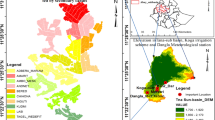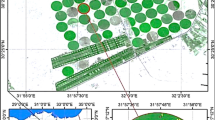Abstract
The Kingdom of Saudi Arabia (KSA) is under extreme water shortage conditions. About 80 % of water in KSA is utilized by the agricultural sector; therefore, proper management of irrigation water is required to produce more food from less water. Water productivity concept was emerged and successfully quantified with the use of remote sensing as well as variable-rate application technologies. In this study, water productivity (WP) of three major crops (alfalfa, corn and Rhodes grass), cultivated in the Eastern Province of KSA under center pivot irrigation system, was estimated using Landsat-8 images in conjunction with in situ field observations. Evapotranspiration (ET)/water use maps (WUM) of irrigated fields was generated from Landsat-8 data using SEBAL model. Subsequently, the crop type and growth stage wise amount of water required for the irrigation was estimated and the irrigation schedules were prepared. Zone based Variable Rate Irrigation (VRI) system was used to optimize the application of irrigation water. Classified ET maps are used as a base for the formulation of prescription map for VRI. The accuracy of SEBAL derived ET maps were assessed against the actual ET recorded by the Eddy Covariance (EC) flux tower installed on an alfalfa field. Crop Productivity Map (CPM) of alfalfa and Rhodes grass were developed using hay yield monitor data, while forage corn productivity was represented by the relationship between the NDVI and sampled silage corn yield (kg m−2). Water productivity map was generated by dividing the CPM with the WUM. The deviation between SEBAL predicted and EC flux tower recorded ET was ranged from 2.92 to 7.13 %. The mean predicted yield (kg ha−1) of alfalfa, corn and Rhodes grass was 2934, 4650 and 3368, respectively. The fields with remote sensing (RS) and VRI application was shown higher WP compared to without RS and VRI inputs. The recorded WP of silage corn, Rhodes grass and Alfalfa with RS and VRI inputs was 1.09, 0.81 and 0.83 respectively, whereas, it was decreased to 1.03, 0.64 and 0.61 kg m−3 respectively for the fields without RS and VRI inputs.







Similar content being viewed by others
References
Al-Gaadi, K. A., Patil, V. C., Tola, E., Madugundu, R., Marey, S. A., Al-Omran, A. M., et al. (2015). Variable rate application technology for optimizing alfalfa production in arid climate. International Journal of Agriculture and Biology, 17, 71–79.
Allen, R. G., Pereira, L. S., Raes, D., & Smith, M. (1998). Crop evapotranspiration: guidelines for computing crop water requirements. Irrigation and drainage, Paper no. 56, FAO, Rome, Italy.
Bastiaanssen, W. G. M. (2000). SEBAL-based sensible and latent heat fluxes in the irrigated Gediz Basin, Turkey. Journal of Hydrology, 229, 87–100.
Bastiaanssen, W. G. M., & Bos, M. G. (1999). Irrigation performance indicators based on remotely sensed data: A review of the literature. Irrigation and Drainage Systems, 13(4), 291–311.
Bastiaanssen, W. G. M., Menenti, M., Feddes, R. A., & Holtslag, A. A. M. (1998). A remote sensing surface energy balance algorithm for land (SEBAL). 1. Formulation. Journal of Hydrology, 212–213, 198–212.
Bastiaanssen, W. G. M., Noordman, E. J. M., Pelgrum, H., Davids, G., Thoreson, B. P., & Allen, R. G. (2005). SEBAL model with remotely sensed data to improve water-resources management under actual field conditions. Journal of Irrigation Drainage Engineering, 131, 85–93.
Biradar, C. M., Thenkabail, P.S., Platonov, A., Xiao, X., Geerken, R., Vithanage, J., et al. (2008). Water productivity mapping methods using remote sensing. Journal of Applied Remote Sensing, 2(1), 023544.22.
Cai, X., & Rosegrant, M. W. (2003). World water productivity: Current situation and future options. In: J. W. Kijne, R. Barker, & D. Molden (Eds.), Water productivity in agriculture: Limits and opportunities for improvement. CAB International, Wallingford, UK, in association with the International Water Management Institute (IWMI), Sri Lanka, pp. 163–178, 354.
Dobermann, A., Ping, J. L., Adamchuk, V. I., Simbahan, G. C. & Ferguson, R. B. (2003). Classification of crop yield variability in irrigated production fields. Agronomy Journal, 95, 1105–1120.
Evans, G. W., & Harting, G. B. (1999). Precision irrigation with center pivot systems on potatoes. In: Proceedings of ASCE 1999 International Water Resources Engineering Conference, August 8–11, Seattle, WA.
Evans, R. G., & King, B. A. (2012). Site-specific sprinkler irrigation in a water-limited future. Transactions of the ASABE, 55, 493–504.
FAO. (1993). Water polices and agriculture. In: The state of food and agriculture, 1993. FAO agriculture series, no. 26, pp. 230–294. ISSN 0081-4539. ISBN 92-5-103360-9.
Farah, O. H., & Bastiaanssen W. G. M. (2001). Impact of spatial variation of land surface parameters on the regional evaporation: case study with remote sensing. Hydrological Processes, 15, 1585–1607.
Farah, H., Bastiaanssen, W., & Feddes, R. (2004). Evaluation of the temporal variability of the evaporative fraction in a tropical watershed. International Journal of Applied Earth Observation and Geoinformation, 5(2), 129–140.
GIS-AG-Maps. (2013). Landsat 8 ESUN (for atmospheric correction), radiance, and TOA reflectance. http://www.gisagmaps.com/landsat-8-atco/. Accessed 18 May 2014.
Gowda, P. H., Chavez, J. L., Colaizzi, P. D., Evett, S. R., Howell, T. A., & Tolk, J. A. (2007). Remote sensing based energy balance algorithms for mapping ET: Current status and future challenges. Transactions of the American Society of Agricultural and Biological Engineers, 50(5), 1639–1644.
Griffin, T. W. (2010). The spatial analysis of yield data. In: Oliver (Ed.) Geostatistical applications for precision agriculture (pp. 89–116). Springer, Netherlands.
Hafeez, M. M., Chemin, Y., Van De Giesen, N., & Buman, B. A. M. (2002). Field evapotranspiration estimation in central Luzon, Philippines, using different sensors: LANDSAT 7 ETM+, Terra MODIS, and ASTER. Symposium on Geospatial Theory, Processing and Applications, Ottawa.
Hanson, R. L. (1991). Evapotranspiration and droughts. In: R. W. Paulson, E. B. Chase, R. S. Roberts, & D. W. Moody (Eds.), National water summary 1988–1989: Hydrologic events and floods and droughts (U.S. Geological Survey Water-Supply Paper 2375) (pp. 99–104). Denver, CO: United States Govt. Printing Press/USGS.
Heerman, D. F., Hoeting, J., & Duke, H. R. (1999). Interdisciplinary irrigated precision farming research. In: J. V. Stafford (Ed.), Proceedings of 2nd European conference on precision agriculture. Sheffield Academic Press, Sheffield, UK, pp. 121–130.
ICARDA. (2007). Sustainable management of natural resources and improvement of the major production systems in the Arabian Peninsula. Final report. 2000–2005 ICARDA—Arabian Peninsula Regional Program. International Center for Agricultural Research in the Dry Areas (ICARDA), Aleppo, Syria, p. 69.
Ismail, S. M., & Al-Marshadi, M. H. (2013). Maximizing productivity and water use efficiency of alfalfa under Precise subsurface drip irrigation in arid regions. Irrigation and Drainage, 62, 57–66.
Jordan, R. W., Duke, H. R., Heermann, D. F., & Buchleiter, G. W. (1999). Spatial variability of water application and percolation under center pivot irrigation. In: J. V. Stafford (Ed.), Proceedings of 2nd European conference on precision agriculture. Sheffield Academic Press, Sheffield, UK, pp. 739–748.
Kalma, J. D., McVicar, T. R., & McCabe, M. F. (2008). Estimating land surface evaporation: A review of methods using remotely sensed surface temperature data. Surveys In Geophysics, 29, 421–469.
Karimi, M., & Gomrokchi, A. (2011). Yield and crop water productivity of corn planted in one or two rows and applying furrow or drip tape irrigation systems in Ghazvin Province, Iran. Irrigation and Drainage, 60, 35–41.
Kettig, R. L., & Landgrebe, D. A. (1976). Classification of multispectral data by extraction and classification of homogeneous objects. IEEE Transactions on Geoscience Electronics, 14, 19–26.
King, B. A., & Kincaid, D. C. (1996). Variable flow sprinkler for site-specific water and nutrient management. ASAE Paper No. 962074. ASAE, St. Joseph, MI.
Lagos, L. O., Martin, D., Verma, S. B., Irmak, S., & Irmak, A. (2013). Surface energy balance model of transpiration from variable canopy cover and evaporation from residue-covered or bare soil systems: model evaluation. Irrigation Science, 31, 135–150.
Mason, D. C., Corr, D. G., Cross, A., Hogg, D. C., Lawrence, D. H., Petrou, M., & Tailor, A. M. (1988). The use of digital map data in the segmentation and classification of remotely-sensed images. International Journal of Geographical Information Systems, 2(3), 195–215.
Matthew, B. (2014). Early analysis of landsat-8 thermal infrared sensor imagery of volcanic activity. Remote Sensing, 6, 2282–2295.
McCabe, M. F., Gao, H., & Wood, E. F. (2005). An evaluation of AMSR-E derived soil moisture retrievals using ground based, airborne and ancillary data during SMEX 02. Journal of Hydrometeorology, 6(6), 864–877.
McCarthy, A. C., Hancock, N. H., & Raine, S. R. (2014). Simulation of irrigation control strategies for cotton using model predictive control within the VARIwise simulation framework. Computers and Electronics in Agriculture, 101, 135–147.
Moayeri, M., Siadat, H., Pazira, E., Abbasi, F., Kaveh, F., & Oweis, T. Y. (2011). Assessment of maize water productivity in southern parts of the Karkheh river basin, Iran. World Applied Sciences Journal, 13(7), 1586–1594.
MOEP. (2010). Water and sanitation. In: The Ninth development plan (2010–2014). Ministry of Economy and Planning, Riyadh, The Kingdom of Saudi Arabia, pp. 493–499.
Owens, J., Bell, L., Rodriguez, D., Whitbread, A., Lawrence, J., & Mann, M. (2008). Comparing the water use efficiency of tropical pasture grasses and legumes used in Queensland’s mixed farming systems. In: M. Unkovich (Ed.), Global issues—Paddock action. Proceedings of 14th agronomy conference, 21–25 September 2008; Adelaide, South Australia.
Patil, V. C., Al-Gaadi, K. A., Madugundu, R., Tola, E., Marey, S., Al-Dosari, A., et al. (2015). Assessing agricultural water productivity in desert farming System of Saudi Arabia. IEEE JSTARS, 8(1), 284–297.
Patil, V. C., Al-Gaadi, K. A., Madugundu, R., Tola, E., Marey, S., Mulla, D. J., & Upadhyaya, S. (2016). Response of Rhodes grass to variable rate application of irrigation water and fertilizer nitrogen. Pakistan Journal of Agricultural Sciences. doi:10.21162/PAKJAS/16.3491. http://www.pakjas.com.pk/inpress/22.pdf
Platonov, A., Thenkabail, P. S., Biradar, C. M., Cai, X., Gumma, M., Dheeravath, V., et al. (2008). Water productivity mapping (WPM) using landsat ETM+ data for the irrigated croplands of the Syrdarya river basin in Central Asia. Sensors, 8, 8156–8180.
Rafiee, M., & Shakarami, G. (2010). Crop water productivity of corn as affected by every other furrow irrigation and planting density. World Applied Sciences Journal, 11(7), 826–829.
Rajeshwari, A., & Mani, N. D. (2014). Estimation of land surface temperature of Dindigul district using landsat 8 data. International Journal of Research in Engineering and Technology, 3(5), 122–126.
Sadler, E. J., Evans, R. G., Buchleiter, G. W., King, B. A., & Camp, C. R. (2000). Design considerations for site specific irrigation. In: R. G. Evans, B. L. Benham, & T. P. Trooien (Eds.), Proceedings of the 4th decennial national irrigation symposium. ASAE, St. Joseph, Michigan, USA, pp. 304–315.
Samani, Z., Bawazir, A. S., Skaggs, R. K., Bleiweiss, M. P., Pinon, A., & Tran, V. (2007). Water use by agricultural crops and Riparian vegetation: An application of remote sensing technology. UCOWR Journal of Contemporary Water Research and Education, 137, 8–13. http://onlinelibrary.wiley.com/doi/10.1111/j.1936-704X.2007.mp137001002.x/epdf.
Shah, T., Molden, D., Sakthivadivel, R., & Seckler, D. (2000). The global groundwater situation: overview of opportunities and challenges. IWMI, Colombo, Sri Lanka, USGS, 2013. http://landsat.usgs.gov/band_designations_landsat_satellites.php
Simbahan, G. C., Dobermann, A., & Ping, J. L. (2004). Screening yield monitor data improves grain yield maps. Agronomy Journal, 96, 1091–1102.
USGS. (2013). Using the USGS Landsat 8 Product. http://landsat7.usgs.gov/Landsat8_Using_Product.php. Accessed 18 May 2014.
Acknowledgments
This project was financially supported by King Saud University, Vice Deanship of Research Chairs. The assistance provided by the graduate students, namely, Eng. Mohammed Elsiddig Ali Abass, Eng. Ahmed Galal Kayad and Eng. Ahmed Zeyada in the field was quite valuable. The unstinted cooperation and support extended by Mr. Jack King and Mr. Alan King is gratefully acknowledged.
Author information
Authors and Affiliations
Corresponding author
About this article
Cite this article
Madugundu, R., Al-Gaadi, K.A., Tola, E. et al. Quantification of Agricultural Water Productivity at Field Scale and Its Implication in On-Farm Water Management. J Indian Soc Remote Sens 45, 643–656 (2017). https://doi.org/10.1007/s12524-016-0623-0
Received:
Accepted:
Published:
Issue Date:
DOI: https://doi.org/10.1007/s12524-016-0623-0




